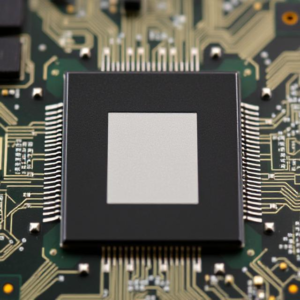System-on-Chip (SoC) Design is a method of creating a complete electronic system on a single chip. Instead of using separate components like processors, memory, and other parts, all of these are integrated together on one chip. This is very important for making compact, efficient, and high-performance devices like smartphones, tablets, smartwatches, and even some home appliances.

Let’s break down the concept in simple terms.
What is a System-on-Chip (SoC)?
An SoC is a single chip that contains:
- Processor(s): This is the brain of the chip, responsible for running programs and tasks (like the CPU or GPU in your phone).
- Memory: The chip includes memory (like RAM or ROM) to store data and instructions temporarily or permanently.
- Input/Output (I/O): It may also include interfaces for communication with other devices (like USB, HDMI, or Bluetooth).
- Power Management: Circuits that handle how the chip consumes and distributes power.
- Additional Specialized Components: For example, a camera processor, audio codec, or networking chip like Wi-Fi or Bluetooth.
- Other Subsystems: Depending on the device, an SoC can also have things like graphics processing units (GPU), image signal processors (ISP), or even machine learning accelerators.
Why SoC Design is Important?
SoC design allows manufacturers to:
- Reduce the size of electronic devices, making them more compact and portable.
- Improve performance by integrating multiple components together, allowing faster communication between them.
- Lower power consumption by using a single chip rather than multiple components.
- Cut costs since manufacturing one chip is cheaper than producing and connecting multiple chips.
Key Elements of SoC Design:
- Processor Core (CPU & GPU):
- The CPU (Central Processing Unit) is the main processing unit that handles general tasks.
- The GPU (Graphics Processing Unit) is specialized for handling graphics and visual tasks, like rendering images or videos.
- Memory:
- SoCs often include different types of memory, such as RAM (for short-term data) and ROM (for long-term data storage).
- Memory is usually integrated on the same chip to speed up access and reduce the physical space needed.
- Interconnects:
- These are high-speed connections that allow communication between different parts of the SoC. For example, the processor communicates with memory, peripherals, and other components via buses or interconnect networks.
- Power Management:
- SoCs are designed to be energy-efficient. They include power management units (PMUs) that help reduce power consumption, which is critical in mobile devices or other battery-powered systems.
- Analog and Digital Components:
- SoCs often have both analog (continuous signal) and digital (binary signal) components. Analog components manage tasks like sound (e.g., microphones, speakers), while digital components handle data processing and communication.
- Peripheral Components:
- SoCs also include circuits for common peripherals like Bluetooth, Wi-Fi, USB, camera interfaces, and audio interfaces. This allows the chip to connect to external devices and sensors.
The Design Process of SoC:
The process of designing an SoC can be very complex, but it follows these general steps:
- Specification:
- Engineers start by determining what the SoC needs to do. For example, if it’s for a smartphone, the SoC should have a powerful CPU, GPU, connectivity options (like Wi-Fi, Bluetooth), and memory management.
- They define all the features, performance goals, power requirements, and cost constraints.
- Architectural Design:
- Next, engineers decide on the architecture of the SoC. This involves choosing the right types of processors (e.g., ARM, RISC), how much memory is needed, and how everything will be connected.
- They also select or design specialized blocks for functions like graphics processing, networking, or audio.
- Design and Simulation:
- At this stage, engineers begin designing the chip using software tools (like Cadence or Synopsys).
- Simulation is done to test how the design will behave. It’s like creating a digital version of the chip and testing how it works under various conditions.
- Fabrication (Manufacturing):
- Once the design is finalized, it is sent to a fab (short for fabrication facility) where the chip is actually built using processes like photolithography.
- This process involves creating the chip layer by layer on a silicon wafer.
- Testing and Debugging:
- After fabrication, engineers test the SoC to check for defects or issues. They test all the components to make sure they work together and meet performance and power goals.
- If issues are found, the design is modified, and the chip may be sent for re-fabrication.
Example of SoC Usage:
Let’s take an example of a smartphone. A smartphone has a lot of functions, including:
- Making phone calls
- Playing music and videos
- Running apps and games
- Connecting to the internet
- Handling sensors like the camera, GPS, and accelerometer
Instead of using separate chips for each function (one for the processor, one for graphics, one for memory, etc.), a single SoC combines:
- A powerful CPU to handle tasks.
- A GPU to handle graphics for games and videos.
- Memory for temporary data storage.
- Connectivity modules like Wi-Fi and Bluetooth.
- Power management to control the battery usage.
- Camera processors to handle photo and video capture.
By combining all these functions into one chip, the smartphone becomes smaller, lighter, more energy-efficient, and cheaper to produce.
Benefits of SoC Design:
- Compactness: Since all components are on one chip, devices can be made smaller and lighter.
- Power Efficiency: SoCs use less power compared to using separate chips for each function, which is crucial for battery-operated devices.
- Cost-Effective: It reduces the cost of production because only one chip needs to be made and packaged.
- Performance: SoCs can offer high performance because the components are directly connected on the same chip, enabling faster communication and lower latency.
- Integration: Multiple functionalities can be integrated, which allows the device to perform various tasks efficiently.
Challenges in SoC Design:
- Heat Dissipation: With so many components packed together, managing heat in SoCs becomes a challenge. Overheating can lead to failures.
- Complexity: Designing a high-performance SoC that handles many tasks at once is very complex. It requires careful planning, expertise, and testing.
- Power Consumption: While SoCs are energy-efficient, they still need to be carefully designed to ensure that power consumption is optimized, especially for mobile devices where battery life is important.
Conclusion:
System-on-Chip (SoC) design allows for the integration of many different components (CPU, memory, graphics, and more) onto a single chip. This design is essential for creating smaller, more powerful, and energy-efficient devices, especially in the world of smartphones, tablets, wearables, and other consumer electronics. By combining all these functions in one chip, SoC design helps to reduce costs, improve performance, and make modern devices more efficient.











